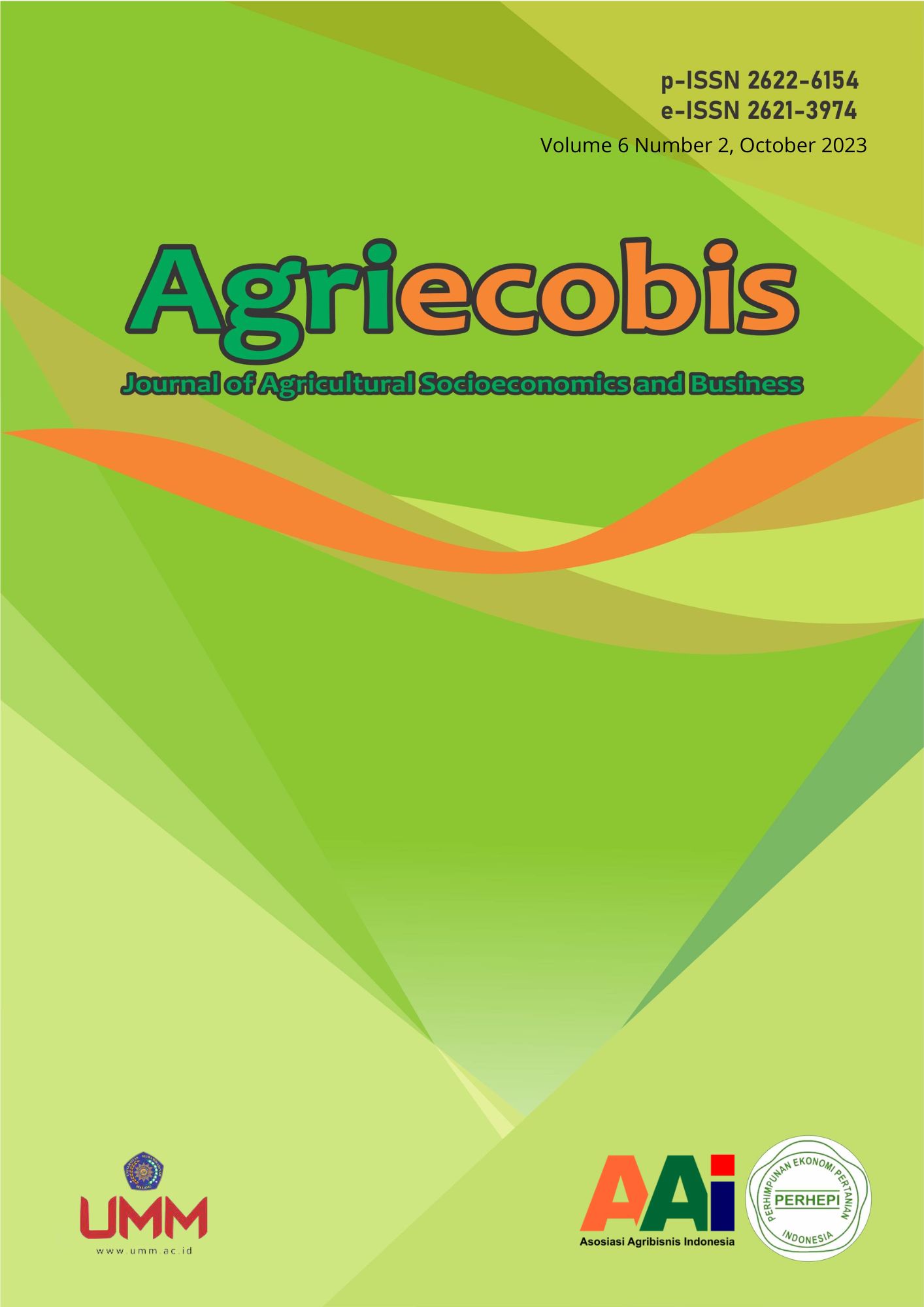Farm Income Analysis of Shallot Farmers in Dulang, Enrekang, South Sulawesi
DOI:
https://doi.org/10.22219/agriecobis.v6i02.29602Keywords:
Agriculture, Shallot, IncomeAbstract
Shallot, recognized primarily as a spice vegetable, serves a pivotal role within the realm of vegetables. This study, undertaken in Dulang, Malua, Enrekang, South Sulawesi, Indonesia, a prominent hub for shallot production in the Enrekang Regency, involved 90 respondents comprising shallot farmers. The principal objective of this research is to ascertain the income generated by these farmers. Employing a survey method, the study gathered data through direct interviews with shallot farmers, selected through a simple random sampling approach. The findings revealed that the average yield from shallot cultivation ranged between IDR 40,000,000 and IDR 50,000,000 per harvest. This outcome suggests the economic viability of shallot production in Dulang, Malua, Enrekang, South Sulawesi, Indonesia.
Downloads
References
Adetya, A., Program, I. S., & Agribisnis, S. (2021). Analisis Produksi, Pendapatan Dan Risiko Usahatani Bawang Merah Di Kecamatan Sokobanah Kabupaten Sampang Provinsi Jawa Timur. Jurnal Agriscience, 2, 17–31. http://journal.trunojoyo.ac.id/agriscience
Arham, Nurhapsa Kartini. (2015). Analisis Pendapatan Dan Kelayakan Usahatani Bawang Merah Di Kecamatan Anggeraja Kabupaten Enrekang. Jurnal Galung Tropika, 4(3), 137–143.
Arniati, M. I. I. M. A. I. (2023). Analisis Pendapatan Petani Bawang Merah Di Desa Masalle Kecamatan Masalle Kabupaten Enrekang. JUMADI, 1 No 2, 107–123. https://doi.org/10.56314/jumabi.v1i2
Farianto, A., Karyani, T., & Trimo, L. (2021). Komparasi Pendapatan Usahatani Bawang Merah Berdasarkan Sumber Pembiayaan di Kabupaten Nganjuk. Jurnal Agribisnis Indonesia, 9(2), 88–104. https://doi.org/10.29244/jai.2021.9.2.88-104
Indriani, Jabal Tarik Ibrahim, B. Y. A. (2022). Strategi pemasaran untuk meningkatkan pendapatan pengrajin keripik tempe di sanan. Jurnal Cemara, 19(2021), 43–52.
Rahim, A., Mk, P., & Soci, E. (2022). Pengaruh Penggunaan Lampu LED sebagai Perangkap Hama terhadap Pendapatan The Effect of Using LED Lights as Pest Traps on the Income of Shallot Farmers in Kolai Village, Malua District, Enrekang Regency. In Jurnal Daun (Vol. 9, Issue 2).
Shodiq, W. M. (2022). Model CPRV (Cost, Productivity, Risk dan Value-Added) dalam Upaya Meningkatkan Pendapatan Petani Indonesia: A Review. Jurnal Hexagro, 6(2), 115–127. https://doi.org/10.36423/hexagro.v6i2.657
Thamrin, M., Novita, D., & Hasanah, U. (2018). Kontribusi Pendapatan Pengupas Bawang Merah Terhadap Pendapatan Keluarga Contribution of Shallot Peeler Revenue to Family Income.
Muhammad Idrus. (2013). Analisis Pendapatan Usaha Tani Bawang Merah Di Kelurahan Mataran Kecamatan Anggeraja Kabupaten Enrekang. Jurnal Economix , 1(2), 94–103.
Panurat, S. M. (2014). Faktor-Faktor Yang Mempengaruhi Minat Petani Berusahatani Padi Di Desa Sendangan Kecamatan Kakas Kabupaten Minahasa.
Downloads
Published
How to Cite
Issue
Section
License
Copyright (c) 2023 Agriecobis : Journal of Agricultural Socioeconomics and Business

This work is licensed under a Creative Commons Attribution-ShareAlike 4.0 International License.
Authors who publish with Agriecobis : Journal of Agricultural Socioeconomics and Business agree to the following terms:
- For all articles published in Agriecobis : Journal of Agricultural Socioeconomics and Business, copyright is retained by the authors. Authors give permission to the publisher to announce the work with conditions. When the manuscript is accepted for publication, the authors agree to automatic transfer of the publishing right to the publisher.
- Authors retain copyright and grant the journal right of first publication with the work simultaneously licensed under a Creative Commons Attribution-ShareAlike 4.0 International License that allows others to share the work with an acknowledgment of the work's authorship and initial publication in this journal.
- Authors are able to enter into separate, additional contractual arrangements for the non-exclusive distribution of the journal's published version of the work (e.g., post it to an institutional repository or publish it in a book), with an acknowledgment of its initial publication in this journal.
- Authors are permitted and encouraged to post their work online (e.g., in institutional repositories or on their website) prior to and during the submission process, as it can lead to productive exchanges, as well as earlier and greater citation of published wor (See The Effect of Open Access).

This work is licensed under a Creative Commons Attribution-ShareAlike 4.0 International License.







